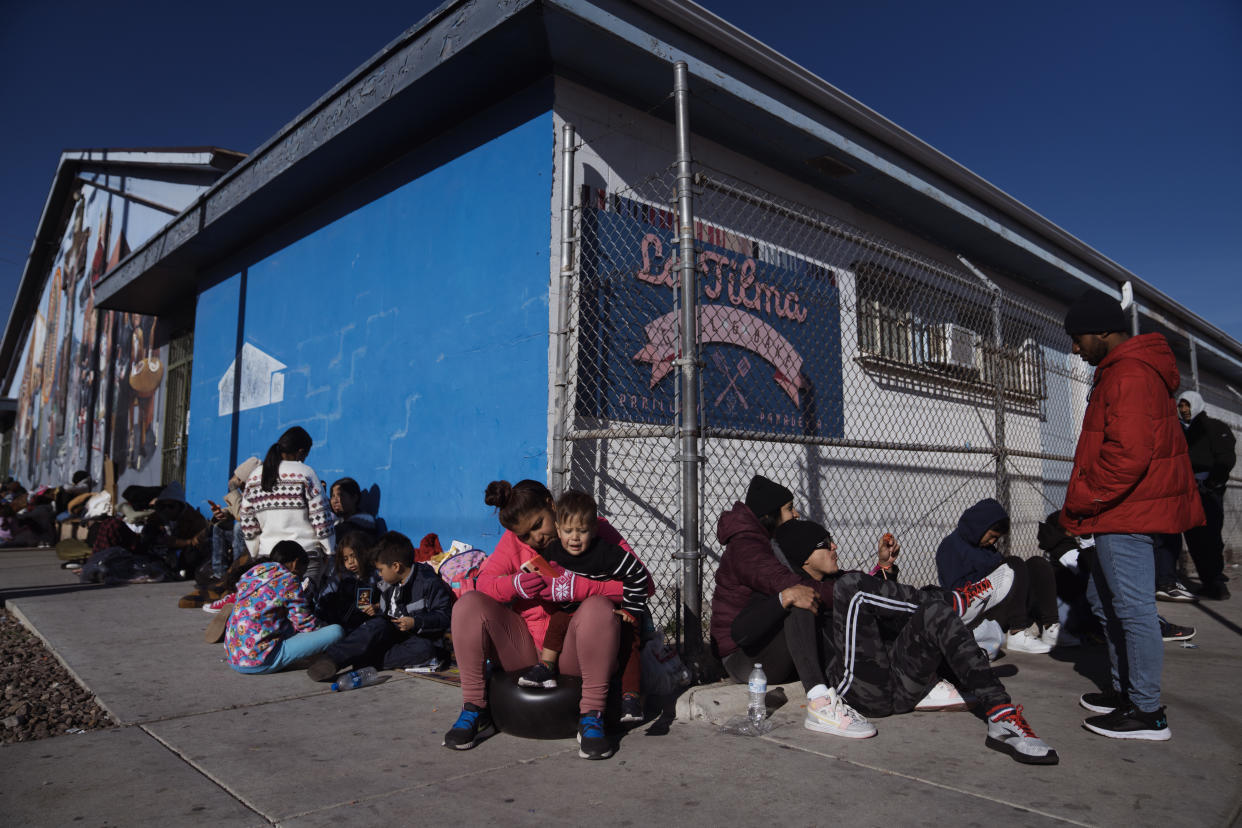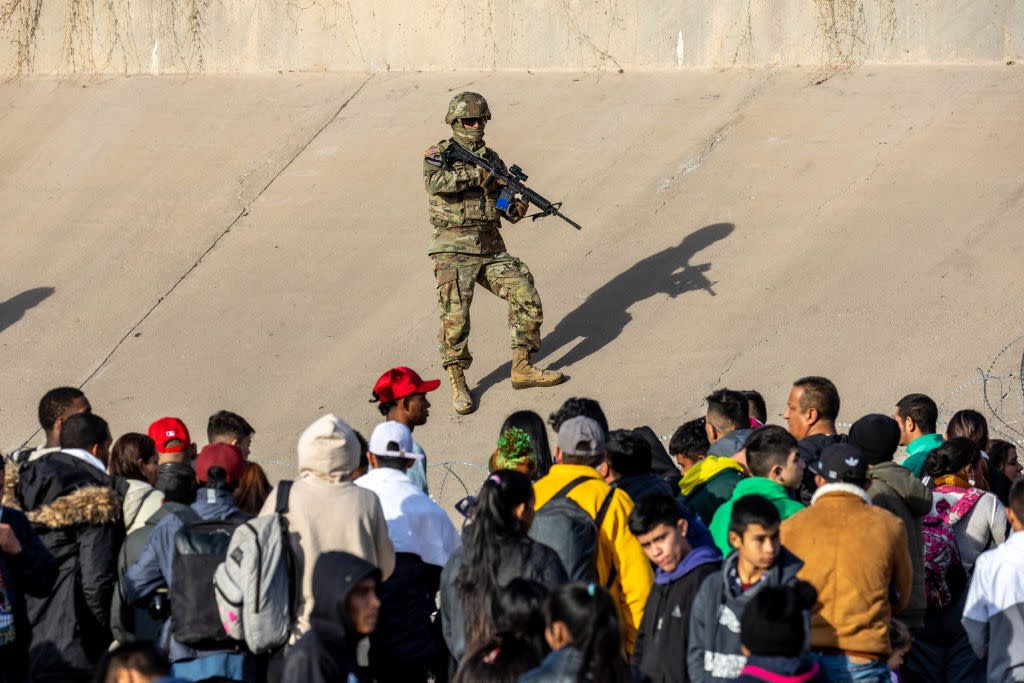Supreme Court will decide if Trump-era ban on asylum seekers can be lifted
The fate of Title 42, the controversial public health order that has been used to deny migrants the right to seek asylum since the start of the coronavirus pandemic, will soon be decided by the Supreme Court.
Just days before the policy was set to expire this week, Chief Justice John Roberts issued a temporary stay allowing the border restriction to remain intact for now, in response to a last-minute appeal from a group of Republican-led states, which argued that lifting the policy would cause “irreparable harm.”
In a court filing Tuesday evening, the government argued that the policy should be allowed to end, as “it is no longer supported by public-health conditions,” but asked the court for more time to prepare, acknowledging that the end of Title 42 would “likely lead to disruption and a temporary increase in unlawful border crossings.”
As the Supreme Court considers what to do next, here’s what you should know about Title 42, how it’s been used during the pandemic and what will happen once it’s lifted.
What is Title 42?

The name “Title 42” refers to a previously obscure clause in the 1944 Public Health Service Act, which allows the government to prohibit noncitizens from countries suffering from an outbreak of a communicable disease from entering the U.S. if such a restriction is deemed necessary “in the interest of the public health.”
The Trump administration invoked Title 42 in the early days of the coronavirus pandemic with an emergency order from the Centers for Disease Control and Prevention, which directed border officials to suspend entry into the country for anyone traveling from Mexico or Canada who would need to be placed in the kinds of congregate settings, such as Border Patrol stations or ports of entry, where undocumented migrants requesting asylum are often temporarily held.
Though the CDC order described the measure as “necessary to protect the public health from an increase in the serious danger of the introduction of Coronavirus Disease 2019,” the Trump administration’s use of Title 42 in this context was condemned by both human rights advocates and many public health experts, who argued that the CDC order was “based on specious justifications and fails to protect public health.”
In a May 2020 letter to then-CDC Director Robert Redfield, several leading public health experts called for the Title 42 order to be rescinded, accusing the administration of using public health as a pretext “to target certain classes of noncitizens rather than to protect public health,” and urged the CDC to consider other “evidence-based public health measures to process asylum seekers and other persons crossing the U.S. border.”
For example, instead of detaining asylum seekers in congregate settings at the border, they suggested, authorities could grant parole to those with family or friends in the country who can house them while they wait for a court hearing.
Critics of the measure hoped it would be lifted once Joe Biden took office. Instead, the Biden administration continued to enforce it for nearly two years, defending it publicly and in federal court, and in recent months had even reportedly considered expanding its use.
Both U.S. and international law require that anyone who expresses a credible fear of returning to their home country be given the chance to seek asylum in the United States, regardless of how they got into the country. But the CDC’s Title 42 order allowed immigration officials to circumvent the regular legal processes for asylum seekers and quickly expel migrants encountered at the southern border, including many who might have otherwise been eligible for humanitarian protections.
Who has been impacted by Title 42?

Since March 2020, immigration authorities have used Title 42 to expel migrants encountered at the southern border 2.5 million times, with the majority of those expulsions taking place during the Biden administration. Because such expulsions do not carry legal consequences, immigration experts have pointed to Title 42 as fueling a substantial increase in repeat border crossings, particularly among single adults, many of whom have been apprehended again after being returned to Mexico.
Not all migrants who reach the southern border are subject to Title 42, however. According to an analysis by CNN, which looked at Customs and Border Protection apprehension data over 10 months earlier this year, Title 42 restrictions were applied in only about 50% of migrant encounters on the southwest border.
Under the Biden administration, the restriction has not been used to turn away unaccompanied children, just families or single adults. It has also been unevenly enforced based on the nationality of migrants and whether they can easily be returned to their home country or Mexico. For example, Nicaraguan and Cuban migrants are exempt from Title 42 because neither Mexico nor their own governments will allow them to be returned.
As a result, the vast majority of migrants who’ve been expelled under Title 42 have been from Mexico, Guatemala, Honduras and El Salvador.
Why is Title 42 now potentially about to expire?
If it seems like Title 42 has been on the verge of ending before, that’s because it has. Back in April, the CDC announced that Title 42 was “no longer necessary” to mitigate the spread of COVID-19 in the U.S. and directed the Department of Homeland Security to prepare to lift the Trump-era restrictions by May 23.
But that decision faced swift backlash from many Republicans, and also some Democrats, who warned that the administration was ill-prepared to handle the potential surge of migrants that was expected to follow the end of Title 42, and expressed concerns that their states would have to shoulder the burden.
That’s when the current legal battle over terminating the measure began. Ahead of the initial May 23 deadline, a group of GOP-led states sued to block the termination of the policy and they found support from a federal judge in Louisiana, who ruled that the Biden administration had not followed proper procedures for lifting the emergency order.
The Biden administration continued to enforce the public health measure per the Louisiana judge’s order until last month, when a federal judge in Washington, D.C., ruled that the government’s use of Title 42 to expel migrants at the border was “arbitrary and capricious in violation of the Administrative Procedure Act.”
Notably, this time around, the Biden administration did not fight to defend Title 42, as it had in the past, and instead agreed to terminate the policy by the new deadline of Dec. 21.
What will happen once Title 42 is lifted?

The eventual end of Title 42 is predicted to drive at least a temporary surge in unauthorized crossings along the U.S.-Mexico border, something Homeland Security officials have said they’ve been anticipating, and preparing for, for several months.
Earlier this week the White House reported that about 23,000 border agents had been dispatched to the southern border. Following the temporary stay order from the Supreme Court on Monday evening, DHS issued a statement saying that it “will continue our preparations to manage the border in a safe, orderly, and humane way when the Title 42 public health order lifts.”
And yet, as of Wednesday, the administration seemed to still be finalizing a plan to address the volume of asylum seekers on the country’s doorstep who will soon no longer be subject to expulsion under Title 42.
In its filing Tuesday evening, the Biden administration asked the Supreme Court to keep Title 42 in place until after Christmas to give the government more time to prepare for a full return to pre-pandemic operations, “with new policies tailored to the consequences of the end of the Title 42 orders — a complex, multi-agency undertaking with policy, operational, and foreign relations dimensions.”
Among the new policies reportedly in the works is a program that would allow asylum seekers to apply for protections through an online portal and, if they cleared an initial screening, to receive documents to fly to the U.S. legally instead of making the dangerous journey to the border.
The Biden administration is also reportedly considering a policy that would effectively make most migrants at the border ineligible for asylum — a move that is expected to face pushback from immigration and human rights advocates.
The proposal, which requires migrants who traveled through another country, such as Mexico, on their way to the U.S. to first apply for — and be denied — asylum in that country before they can seek protections here, bears a striking resemblance to another controversial Trump-era policy known as the transit ban.
The Trump transit ban was implemented in 2019 and later struck down by a San Francisco federal appeals court, which ruled that the policy violated federal asylum laws.
Biden scrapped the ban, along with several other Trump-era immigration policies, soon after taking office but is now reported to be reconsidering it as the government prepares for a likely surge in migration following the end of Title 42.
